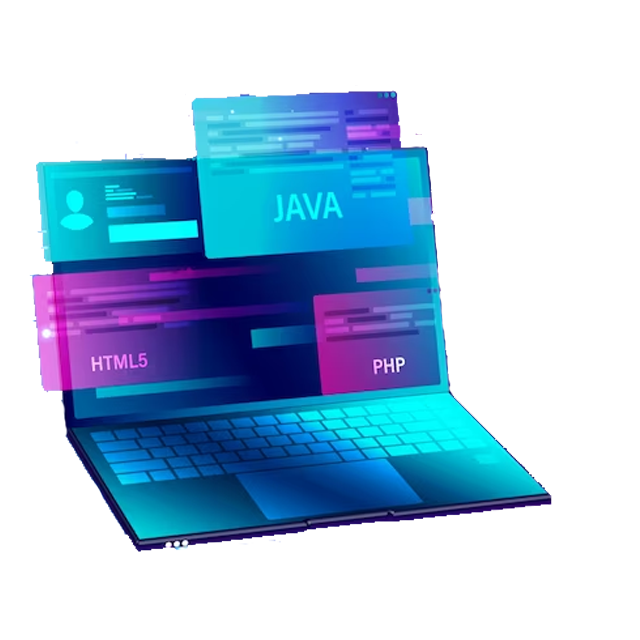Make Us Your Java Security Partner
Java is a statically typed object-oriented programming language designed for portability across various types of devices.
Once java source code is compiled on one device, it can run on any device ranging from windows to ios devices including linux systems.
It is similar to C++ language but the applications developed in Java are a bit slower in execution than those developed in C++.
The most striking feature of java is automatic garbage collection which means it deallocates all the memory automatically which has been dynamically allocated from the heap memory.
Also it is open source and free, so it is the most popular language in the world owing to its portability and flexibility.
Java is a secure language as it incorporates run-time security checks for new code execution,byte-code verification before execution, security API’s.



How we help you
Become our partner and let us help each other grow and take the next step of success together.
INVESICS provides for all the WordPress security needs.
Imagine you have a great website and have "admin" as your administrator username. This is an invitation to hackers. Avoid such wordpress security mistakes and protect the loss of reputation,loss of revenue.


Java Architecture
Java source code compilation to machine code is divided into two steps, interpretation and compilation which is handled by three main components of its architecture: JVM, JRE and JDK.
JVM or Java Virtual Machine is the component where the actual java programs are executed in the device. It interprets the compiled java bytecode to machine code and provides a runtime environment for the application to execute.
JRE or Java Runtime Environment builds an runtime environment for java applications to execute, it links your java source code with the needed libraries and initiates the jvm to execute the program.
JDK or Java Development Toolkit is an development suite used for developing java programs, it contains jre, needed libraries, java executable, java compiler and other required tools for creating and executing java programs in any device, or we can say that jvm and jre are bundled inside jdk.
How can we meet your Needs
Speak to a member of our leadership team today
Methods
Practices to Secure Java Programs
Use parameterized queries
Many attackers easily infiltrate databases using sql injection attacks on backend databases of any java applet, to prevent this use sql queries that are parameterized so that any malicious user cannot input special characters in order to perform the attack.Properly configure xml parsers
XML parsers used in java applets are vulnerable to xxe attacks in which malicious xml entities are injected into the applet. Always make sure that you disallow external entities and allow only entities having defined format.Scan dependencies for loopholes
Many data breaches occur due to outdated applet dependencies, so make sure that all of the dependencies and libraries are updated with the latest security patches, if any released.Don’t use java deserialization
Serialization is the process of converting any javascript object into a byte stream, but during decoding we are not aware whether the stream is malicious or not, so don’t use deserialization methods in java before analyzing the stream contents.Use input sanitization
Mishandling of input may lead to xss attacks, so always make sure that only trusted input is passed to the server.Use strong encryption and hashing algorithms
While storing or transmitting data, always make sure you use proper encryption algorithms to encrypt or encode your data to protect it from data breaches.Java Vulnerabilities
CVE-2019-2842
Vulnerability in java applets caused any unauthorized attacker to access java se through network in order to compromise it to cause denial of service attack.CVE-2019-2821
Vulnerability in java se versions 11.0.3 and 12.0.1 allowed any unauthenticated attacker to compromise java se by accessing via tls protocol network.CVE-2019-2818
Vulnerability that allowed any other person to interact with java applet deployments while accessing through various network protocols.CVE-2019-2816
Vulnerability in java se versions 11.0.3 and 12.0.1 allowed any unauthenticated attacker to compromise java se by accessing via tls protocol network any update, delete or insert java se deployment data.CVE-2019-2786
Vulnerability that allows any unauthorized attacker with the help of an authorized person to access sensitive data stored in embedded java se components.CVE-2019-2769
Vulnerability that allows any unauthenticated attacker to access java se component by accessing via various network protocols which could lead to denial of service attacks.CVE-2019-2766
Vulnerability that allows any unauthorized attacker to access java se component that could lead to data breach of otherwise inaccessible database of java se embedded component.Methods to security test java applets
Intercept the communication and check whether the data is transferred using https protocol, as most of the attackers usually intercept the communication to gather data as data is sent in plain text and https uses encryption so, the data cannot be easily intercepted.
Check whether the sensitive data is stored in an easily accessible location so that it can be stolen by any attacker gaining access into the java applet database.
Also perform memory analysis of the java applet to find any temporarily stored credentials as that might be intercepted easily.
Try to bypass client-side validation by performing reverse engineering of the java applet, as most of the attackers perform input based attacks by modifying the input using some special characters.


Explore How Invesics Can Become Your Digital Guard!
Find out from our cyber-security experts on a FREE consultation call